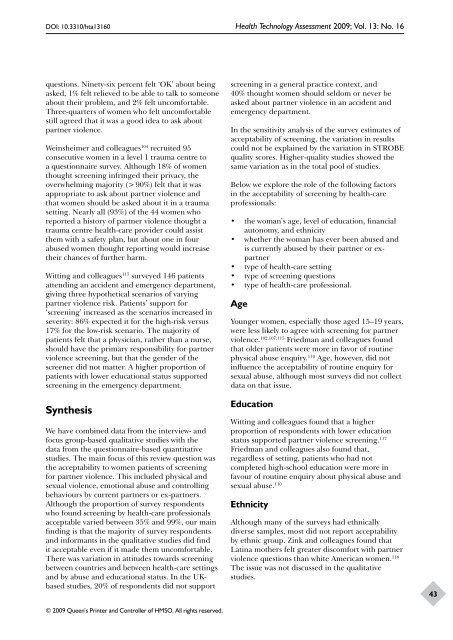How far does screening women for domestic (partner) - NIHR Health ...
How far does screening women for domestic (partner) - NIHR Health ...
How far does screening women for domestic (partner) - NIHR Health ...
Create successful ePaper yourself
Turn your PDF publications into a flip-book with our unique Google optimized e-Paper software.
DOI: 10.3310/hta13160 <strong>Health</strong> Technology Assessment 2009; Vol. 13: No. 16<br />
questions. Ninety-six percent felt ‘OK’ about being<br />
asked, 1% felt relieved to be able to talk to someone<br />
about their problem, and 2% felt uncom<strong>for</strong>table.<br />
Three-quarters of <strong>women</strong> who felt uncom<strong>for</strong>table<br />
still agreed that it was a good idea to ask about<br />
<strong>partner</strong> violence.<br />
Weinsheimer and colleagues 104 recruited 95<br />
consecutive <strong>women</strong> in a level 1 trauma centre to<br />
a questionnaire survey. Although 18% of <strong>women</strong><br />
thought <strong>screening</strong> infringed their privacy, the<br />
overwhelming majority (> 90%) felt that it was<br />
appropriate to ask about <strong>partner</strong> violence and<br />
that <strong>women</strong> should be asked about it in a trauma<br />
setting. Nearly all (93%) of the 44 <strong>women</strong> who<br />
reported a history of <strong>partner</strong> violence thought a<br />
trauma centre health-care provider could assist<br />
them with a safety plan, but about one in four<br />
abused <strong>women</strong> thought reporting would increase<br />
their chances of further harm.<br />
Witting and colleagues 117 surveyed 146 patients<br />
attending an accident and emergency department,<br />
giving three hypothetical scenarios of varying<br />
<strong>partner</strong> violence risk. Patients’ support <strong>for</strong><br />
‘<strong>screening</strong>’ increased as the scenarios increased in<br />
severity: 86% expected it <strong>for</strong> the high-risk versus<br />
17% <strong>for</strong> the low-risk scenario. The majority of<br />
patients felt that a physician, rather than a nurse,<br />
should have the primary responsibility <strong>for</strong> <strong>partner</strong><br />
violence <strong>screening</strong>, but that the gender of the<br />
screener did not matter. A higher proportion of<br />
patients with lower educational status supported<br />
<strong>screening</strong> in the emergency department.<br />
Synthesis<br />
We have combined data from the interview- and<br />
focus group-based qualitative studies with the<br />
data from the questionnaire-based quantitative<br />
studies. The main focus of this review question was<br />
the acceptability to <strong>women</strong> patients of <strong>screening</strong><br />
<strong>for</strong> <strong>partner</strong> violence. This included physical and<br />
sexual violence, emotional abuse and controlling<br />
behaviours by current <strong>partner</strong>s or ex-<strong>partner</strong>s.<br />
Although the proportion of survey respondents<br />
who found <strong>screening</strong> by health-care professionals<br />
acceptable varied between 35% and 99%, our main<br />
finding is that the majority of survey respondents<br />
and in<strong>for</strong>mants in the qualitative studies did find<br />
it acceptable even if it made them uncom<strong>for</strong>table.<br />
There was variation in attitudes towards <strong>screening</strong><br />
between countries and between health-care settings<br />
and by abuse and educational status. In the UKbased<br />
studies, 20% of respondents did not support<br />
© 2009 Queen’s Printer and Controller of HMSO. All rights reserved.<br />
<strong>screening</strong> in a general practice context, and<br />
40% thought <strong>women</strong> should seldom or never be<br />
asked about <strong>partner</strong> violence in an accident and<br />
emergency department.<br />
In the sensitivity analysis of the survey estimates of<br />
acceptability of <strong>screening</strong>, the variation in results<br />
could not be explained by the variation in STROBE<br />
quality scores. Higher-quality studies showed the<br />
same variation as in the total pool of studies.<br />
Below we explore the role of the following factors<br />
in the acceptability of <strong>screening</strong> by health-care<br />
professionals:<br />
• the woman’s age, level of education, financial<br />
autonomy, and ethnicity<br />
• whether the woman has ever been abused and<br />
is currently abused by their <strong>partner</strong> or ex<strong>partner</strong><br />
• type of health-care setting<br />
• type of <strong>screening</strong> questions<br />
• type of health-care professional.<br />
Age<br />
Younger <strong>women</strong>, especially those aged 15–19 years,<br />
were less likely to agree with <strong>screening</strong> <strong>for</strong> <strong>partner</strong><br />
violence. 102,107,115 Friedman and colleagues found<br />
that older patients were more in favor of routine<br />
physical abuse enquiry. 110 Age, however, did not<br />
influence the acceptability of routine enquiry <strong>for</strong><br />
sexual abuse, although most surveys did not collect<br />
data on that issue.<br />
Education<br />
Witting and colleagues found that a higher<br />
proportion of respondents with lower education<br />
status supported <strong>partner</strong> violence <strong>screening</strong>. 117<br />
Friedman and colleagues also found that,<br />
regardless of setting, patients who had not<br />
completed high-school education were more in<br />
favour of routine enquiry about physical abuse and<br />
sexual abuse. 110<br />
Ethnicity<br />
Although many of the surveys had ethnically<br />
diverse samples, most did not report acceptability<br />
by ethnic group. Zink and colleagues found that<br />
Latina mothers felt greater discom<strong>for</strong>t with <strong>partner</strong><br />
violence questions than white American <strong>women</strong>. 118<br />
The issue was not discussed in the qualitative<br />
studies.<br />
43
















